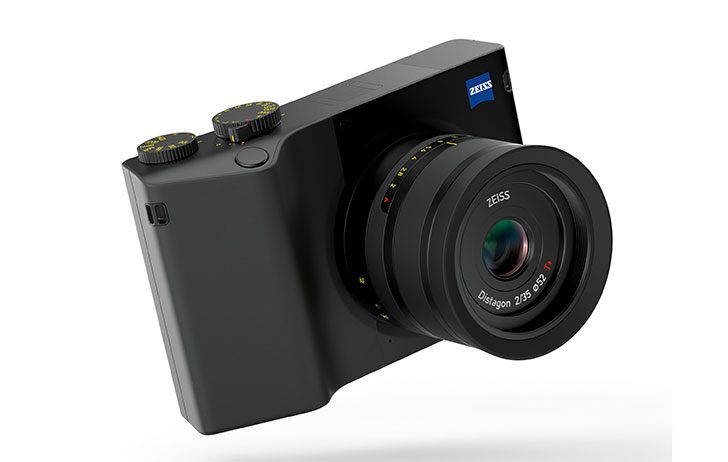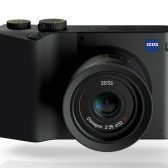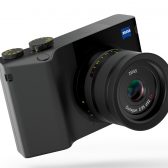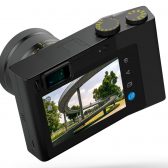First full-frame camera from ZEISS with first-class image quality and the familiar, intuitive image editing and connectivity of a smartphone.
OBERKOCHEN/Germany, 2018-09-27.
ZEISS ZX1 – That is the name of the newly developed mirrorless full-frame camera from ZEISS that was presented today in Cologne, Germany. Thanks to the ZEISS lens and a sensor developed in-house at ZEISS, the camera delivers first-class image quality combined with an operational concept and user experience that make the photographer's jobs-to-be-done as intuitive as on a smartphone.
The ZEISS camera concept is just the first step to opening up a new world of possibilities for ambitious photographers – from taking the shot to editing the image and sharing it on the web.
SHOOT. EDIT. SHARE. – Harmonized hardware, software and optics for a seamless creative process
SHOOT: the ZEISS ZX1 features a newly designed, integrated ZEISS Distagon 35 mm f/2 T* lens with autofocus that has been perfectly matched to the 37.4 megapixel full-frame sensor developed in-house at ZEISS. The interplay between the lens and sensor ensures first-class picture quality with that typical ZEISS look.
EDIT: The ZEISS ZX1 enables photographers to professionally process RAW images directly on the camera thanks to fully integrated Adobe Photoshop Lightroom CC. Moreover, the ZEISS ZX1's unique user interface supports the user's particular workflow without any interruption – providing direct access to the most frequently used functions via a 4.3″ multi-touch display.
SHARE: when the networked full-frame camera is connected, the user can upload selected images directly to the internet – without the intermediate transfer to memory cards or other external devices.
512 GB of internal memory provide sufficient space for approximately 6,800 RAW files (DNG) or over 50,000 JPGs – more than enough to handle photos, even during a longer trip, and giving the photographer the chance to let their creativity flow. Versatile connectivity options such as Wi-Fi, Bluetooth and USB-C ensure that various peripherals can be connected. Over-the-air software updates keep the camera up to date without requiring a computer connection.
Designed with a passion for detail and a focus on the essentials
The design of the ZEISS ZX1 is characterized by its iconic shape with carefully crafted details. The overall form and reduction to just those elements that are absolutely necessary lay the foundation for an ergonomic camera and ensure easy handling. The symbiosis of hardware and software is exemplified by the newly defined user interface that utilizes the 4.3″ multi-touch display. The slightly bent screen separates the live view from the control elements, making camera operation comfortable and straightforward.
“We know that we exploring new ways and initially addressing a special target group with the ZEISS ZX1. With our concept we are focusing on ambitious, professional creatives who want to produce their photographic experiences quickly and efficiently, and inspire as many people on the Internet as possible. This requires a streamlined workflow in addition to high-end features. This is exactly what the concept of the ZEISS ZX1 offers,” explains Jörg Schmitz, Head of the Consumer Products business group at ZEISS.
ZEISS ZX1 available from early 2019
The ZEISS ZX1 will be available at selected dealers in early 2019. ZEISS will announce the recommended retail price at the start of the official market launch. Starting now, anyone interested in receiving information on exact availability can register at www.zeiss.com/zx1.





They likely have a price target, but, until they actually start building them and seeing the competition, they won't want to commit to a price.
I'd heard the rumours that this was coming but knew little about it. Now it seems like it could be a really interesting addition to my camera collection, depending on price. It may not be for everyone, but I can see myself using these features. Be still my GAS.
isn't lightroom mobile free?
i'm more interested in the other hardware attached to that sensor..it must be some mid-high end smartphone hardware inside with some very light OS that boots really fast and directly starts the camera app inside lightroom..
What is interesting is that this is the first Zeiss camera after the Icon, I think. They have been making high end microscope cameras for quite some time but that is in the microscopy division and not in the camera division. Very different beasts (peltier cooled CCD, binning options etc.).
But this camera's Zeiss sensor is new, the Axiocams all use Sony sensors, both CCD and CMOS. Or maybe not, since Zeiss says the sensor was developed in house...but maybe still made by Sony.
If I were AvTvM, I'd claim that would mean millions of buyers. :p
photo enthusiast scientists ... well, zeiss might offer them a ZX1 as "free gift" when ordering hi-end gear for the lab. but no, that might be not in compliance, so Zeiss won't do it and even when, scientists would never accept, right? so, back to a few dozen units sold to collectors and their glass cupboards.
other than that, zeiss ZX1 is way too big and too heavy for what it is: FF sensor with bolted-on, single focal length 35mm/2.0 lens. Can be had in a truly compact package as well.
source: https://www.apotelyt.com/compare-camera/zeiss-zx1-vs-sony-rx1r-ii
ZX1 is a Frankenstein combo of Android mobile gadget - with Adobe Lightroom slapped on top to make things worse - and outdated analog camera days UI concept with 2 mono-functional dials for Tv, ISO and aperture ring. a bit reminiscent of failed UI approach on Nikon Df. No buttons for AE-Lock or AF-L for back-button AF that any serious user would want!? Touchscreen plus fewer dials and buttons makes all sense in the world, but only if implemented "really right". On ZX1 is it "really limiting".
Nice big hi-rez big display, but why not articulated and why 16:9 yuck!, when sensor is still 3:2 ... another of the video-induced compromises that impair stills shooting functionality and user experience.
512GB internal memory, fine. but why not add a UHS II or even better UHS III (Micro) SD slot in addition? For expandability, redundancy and fast transfer whenever wireless options are not available? Body is large enough to fit even dual SD slots, right? And Price will undoubtedly be high enough to cover a few extra bucks for a SD chip and slot, no?
communication - why stop halfway? Only WIFI? If Android, then why not give it built-in LTE/4G chip to eliminate need for a separate smartphone when camera is along.
And if body is that large, why not give it a 24-70/4.0 zoom lens at least, or even better: an interchangable lens mount! eg new L-mount, if it really is "open standard". That would nicely upset Leica and be great fun.
Overall: typical half-assed "concept car" approach: all glitz, all show, nothing road-worthy.
If Zeiss outsources 3/4" sensors on $5-15K cameras, I seriously doubt they would have their own sensor fab for a full size sensor. Even for Zeiss that would involve some serious cash. Maybe it's a custom job made at a Sony .... plant.
I have only used the Axiocam HRc II and III (so the 512 equivalent), and don't do fluorescent work. For stacking, it is a bit of a walled garden with Zen talking to mot focus and camera. Micromanager may be an option, but not sure it is worth it to get flash capability.
My next Zeiss "camera", or rather 24x32k frame grabber, will be on a EVO 10 arriving in about a year or so. Vorfreude ist die schönste Freude!
it's sounds like an april fools joke for me.
But depending on your magnification, much of a 12 MP image is likely empty resolution. The higher the objective magnification, the lower the sensor resolution needed to fully capture the optical resolution. With 100x/1.4 NA, sVGA resolution is really all you need. 1 MP with typical microscopy sensor sizes (up to 1") is fine for most objectives, you only need up to 5 MP if you're going down to a 2.5x objective or lower (or using a 0.63x coupler with a 5x objective). I put a 1x or 1.25x objective on most scopes to capture an overview image of full sections, thus the 506c with 6 MP. Of course, 'we all know' that more MP are better, so Zeiss will happily sell you a 12 MP camera and let you pay more money for extra empty resolution. If you want high-res images of larger areas, tiling of 1 MP images (binning a higher res sensor if needed) and a 10-20x objective is the way to go.
We do quite different imaging, even when using similar equipment. So approaches are different as well. I never had any complaints re image quality in any of my papers. Zeiss thought the images were good enough for their microscopy blog, so apparently they stand up to scrutiny even when using "outdated" equipment. :-) Enjoy your new scope!
The lens look so titchy in that large body and oversized lens mount.